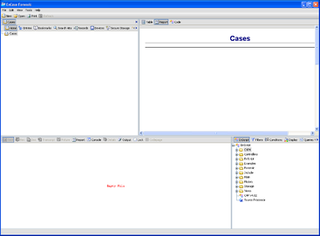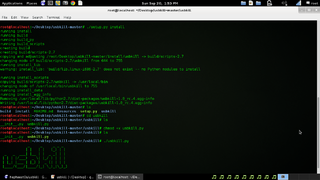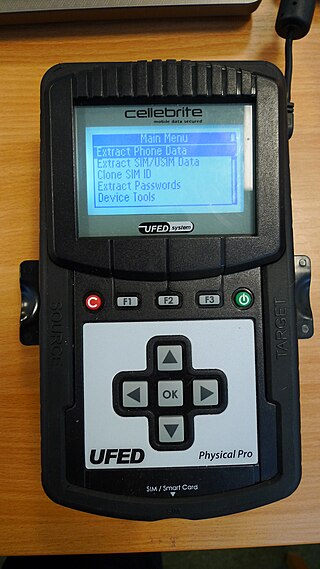
Computer forensics is a branch of digital forensic science pertaining to evidence found in computers and digital storage media. The goal of computer forensics is to examine digital media in a forensically sound manner with the aim of identifying, preserving, recovering, analyzing and presenting facts and opinions about the digital information.

The United States National Drug Intelligence Center (NDIC), established in 1993, was a component of the U.S. Department of Justice and a member of the Intelligence Community. The General Counterdrug Intelligence Plan, implemented in February 2000, designated NDIC as the nation's principal center for strategic domestic counterdrug intelligence.

Digital forensics is a branch of forensic science encompassing the recovery, investigation, examination, and analysis of material found in digital devices, often in relation to mobile devices and computer crime. The term "digital forensics" was originally used as a synonym for computer forensics but has expanded to cover investigation of all devices capable of storing digital data. With roots in the personal computing revolution of the late 1970s and early 1980s, the discipline evolved in a haphazard manner during the 1990s, and it was not until the early 21st century that national policies emerged.
Anti–computer forensics or counter-forensics are techniques used to obstruct forensic analysis.
BasisTech is a software company specializing in applying artificial intelligence techniques to understanding documents and unstructured data written in different languages. It has headquarters in Somerville, Massachusetts with a subsidiary office in Tokyo. Its legal name is BasisTech LLC.

EnCase is the shared technology within a suite of digital investigations products by Guidance Software. The software comes in several products designed for forensic, cyber security, security analytics, and e-discovery use. EnCase is traditionally used in forensics to recover evidence from seized hard drives. It allows the investigator to conduct in-depth analysis of user files to collect evidence such as documents, pictures, internet history and Windows Registry information.
Computer Online Forensic Evidence Extractor (COFEE) is a tool kit, developed by Microsoft, to help computer forensic investigators extract evidence from a Windows computer. Installed on a USB flash drive or other external disk drive, it acts as an automated forensic tool during a live analysis. Microsoft provides COFEE devices and online technical support free to law enforcement agencies.

Document Exploitation (DOCEX) is the set of procedures used by the United States Armed Forces to discover, categorize, and use documents seized in combat operations. In the course of performing its missions in the War on Terrorism, members of the United States Armed Forces discover vast amounts of documents in many formats and languages. When documents are suspected of containing information of potential intelligence value, rapid and accurate interpretation of the information identifies targets, bolsters success in subsequent operations, and enhances tactical and strategic all-source intelligence efforts. The sheer volume of documents acquired in the course of military operations can overwhelm a unit's capability to extract meaningful information in a timely manner.
Cyber spying, cyber espionage, or cyber-collection is the act or practice of obtaining secrets and information without the permission and knowledge of the holder of the information using methods on the Internet, networks or individual computers through the use of proxy servers, cracking techniques and malicious software including Trojan horses and spyware. Cyber espionage can be used to target various actors- individuals, competitors, rivals, groups, governments, and others- in order to obtain personal, economic, political or military advantages. It may wholly be perpetrated online from computer desks of professionals on bases in far away countries or may involve infiltration at home by computer trained conventional spies and moles or in other cases may be the criminal handiwork of amateur malicious hackers and software programmers.

Mobile device forensics is a branch of digital forensics relating to recovery of digital evidence or data from a mobile device under forensically sound conditions. The phrase mobile device usually refers to mobile phones; however, it can also relate to any digital device that has both internal memory and communication ability, including PDA devices, GPS devices and tablet computers.

The digital forensic process is a recognized scientific and forensic process used in digital forensics investigations. Forensics researcher Eoghan Casey defines it as a number of steps from the original incident alert through to reporting of findings. The process is predominantly used in computer and mobile forensic investigations and consists of three steps: acquisition, analysis and reporting.
Cellebrite DI Ltd. is an Israeli digital intelligence company that provides tools for federal, state, and local law enforcement as well as enterprise companies and service providers to collect, review, analyze and manage digital data. On April 8, 2021, Cellebrite announced plans to go public via a merger with a blank-check firm, valuing the company at approximately $2.4 billion. Their flagship product series is the Cellebrite UFED.

The Science and Technology Branch (STB) is service within the Federal Bureau of Investigation that comprises three separate divisions and three program offices. The goal when it was founded in July 2006 was to centralize the leadership and management of the three divisions. The mission of the STB is discover, develop, and deliver innovative science and technology so that intelligence and innovative investigation is enhanced.
Forensic search is an emerging field of computer forensics. Forensic search focuses on user created data such as email files, cell phone records, office documents, PDFs and other files that are easily interpreted by a person.
Autopsy is computer software that makes it simpler to deploy many of the open source programs and plugins used in The Sleuth Kit. The graphical user interface displays the results from the forensic search of the underlying volume, making it easier for investigators to flag pertinent sections of data. The tool is largely maintained by Basis Technology Corp. with the assistance of programmers from the community. The company sells support services and training for using the product.

USBKill is anti-forensic software distributed via GitHub, written in Python for the BSD, Linux, and OS X operating systems. It is designed to serve as a kill switch if the computer on which it is installed should fall under the control of individuals or entities against the desires of the owner. It is free software, available under the GNU General Public License.

Vault 7 is a series of documents that WikiLeaks began to publish on 7 March 2017, detailing the activities and capabilities of the United States Central Intelligence Agency (CIA) to perform electronic surveillance and cyber warfare. The files, dating from 2013 to 2016, include details on the agency's software capabilities, such as the ability to compromise cars, smart TVs, web browsers, and the operating systems of most smartphones, as well as other operating systems such as Microsoft Windows, macOS, and Linux. A CIA internal audit identified 91 malware tools out of more than 500 tools in use in 2016 being compromised by the release. The tools were developed by the Operations Support Branch of the C.I.A.

CAINE Linux is an Italian Linux live distribution managed by Giovanni "Nanni" Bassetti. The project began in 2008 as an environment to foster digital forensics and incidence response (DFIR), with several related tools pre-installed.

The UFED is a product series of the Israeli company Cellebrite, which is used for the extraction and analysis of data from mobile devices by law enforcement agencies.










